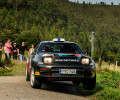EHSRC - Introducing the Rally de Asturias Histórico
The third round of the 2019 FIA European Historic Sporting Rally Championship will be held in the city of Pravia in the Principality of Asturias, North West Spain.

The 11th Rally de Asturias Histórico will start on Thursday 23rd May with the celebration of the Test Day FAPA, where the teams will test their vehicles before the start of the rally. The section chosen for this purpose will be the one between the Aguilar Beach and the town of Aronces with a length of 2.23 km.
Throughout Thursday afternoon, administrative checks and technical scrutineering will take place in Pravia. The administration checks will take place at the Pravia Library and scrutineering in the Secondary Education Institute of Pravia.
At 8:30 p.m, in the Plaza Conde Guadalhorce de Pravia, the Ceremonial Start will be held where the fans can see all of the participating teams in the 11th edition of the Rally de Asturias Histórico for the first time.
Eleven special stages will be held on Friday 24th and Saturday 25th May, with a schedule similar to last year. The special stages will be held over a total of 134.30 kilometers against the clock.
‘Cudillero’ (SS1 / SS3) and ‘Hotel Rey Silo’ (SS2 / SS4) will be the special stages of the first leg, which will both be tackled twice. On Saturday ‘Salas’ (SS6 / SS9) and ‘Soto del Barco’ (SS7 / SS10) will be used twice, while ‘Pravia’ (SS5 / SS8 / SS11) will be used three times. As last year, the Port of Cudillero will be the scene of the Service Park.
CLICK HERE to visit the official rally website
CLICK HERE for a schedule for the 11th Rally de Asturias
A Look Back at 2018
The 2018 Rally de Asturias Histórico saw a high quality entry across the four categories for the 10th edition of the event. Antonio Parisi and Guiseppe D’Angelo won their third Category 1 event in a row on their way to the 2018 class title in their Porsche 911 S.
In category 2 it was the only class win of the 2018 season for the British pairing of Ernie and Karen Graham in the Ford Escort RS1600, finishing 11.8 seconds ahead of Anders and Ingrid Johnsen’s Porsche Carrera RS 3.0.
The category 3 victory went to a local crew, Jesus Ferreiro and Xavier Anido, whose Ford Escort RS1800 finished over two minutes of eventual class champions Karl Wagner and Gerda Zauner in the Porsche 911 SC.
The overall win went to the French crew of Serge Cazaux and Maxime Vilmot in a Ford Sierra Cosworth 4x4, finishing over five minutes ahead of Valter Jensen and Erik Pedersen’s BMW M3.
for the result from the 10th Rally de Asturias HistóricoAbout the Principality of Asturias
The Principality of Asturias is an autonomous community in north-west Spain and is divided into eight comarcas or counties. Asturias contains some of the territory that was part of the larger Kingdom of Asturias, with Pravia being the capital city.
With the beginning of the Moorish conquest in the 8th century, the region became a refuge for Christian nobles and in 722, a de facto independent kingdom was established, the Regnum Asturorum, which was to become the cradle of the incipient Reconquista (Reconquest).
Today Asturias is bordered by Cantabria to the east, by Castile and León to the south, by Galicia to the west, and by the Bay of Biscay to the north. The most important cities are the communal capital, Oviedo, the seaport and largest city Gijón and the industrial town of Avilés.
The key features of Asturian geography are its rugged coastal cliffs and the mountainous interior.
The Cantabrian Mountains (Cordillera Cantábrica) form Asturias's natural border with the province of León to the south. In the eastern range, the Picos de Europa National Park contains the highest and arguably most spectacular mountains, rising to 2,648 metres (8,688 ft) at the Torrecerredo peak.
Other notable features of this predominantly limestone range are the Parque Natural de Redes in the central east, the central Ubiñas south of Oviedo, and the Parque Natural de Somiedo in the west.
The Asturian coastline is extensive, with hundreds of beaches, coves and natural sea caves.
The climate of Asturias is heavily influenced by the gulf stream with mild summer temperatures.
CLICK HERE for more information on Asturias on the official Spanish Tourism website


 Facebook
Facebook Twitter
Twitter






